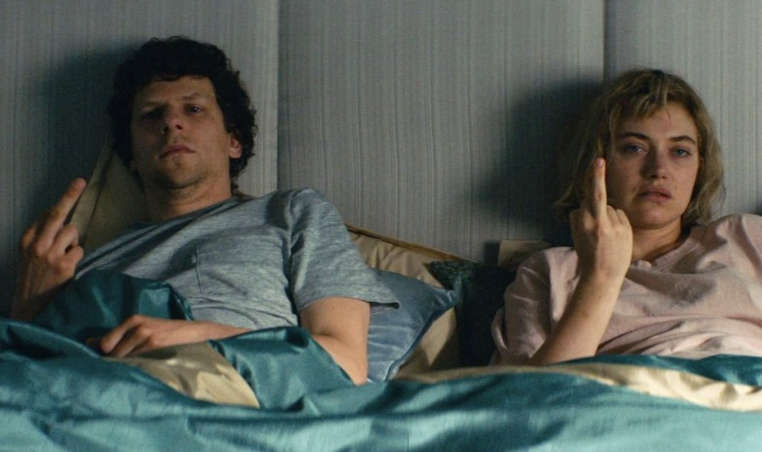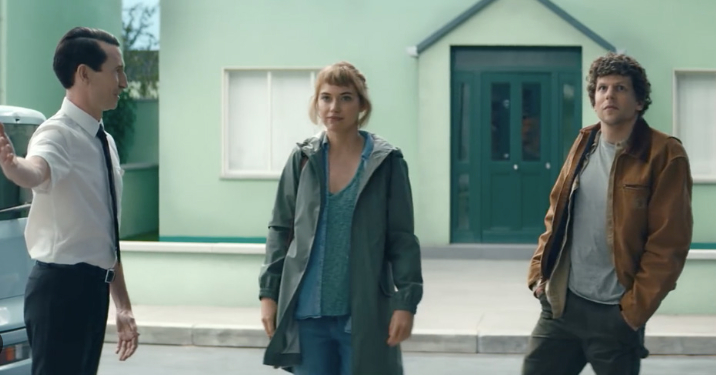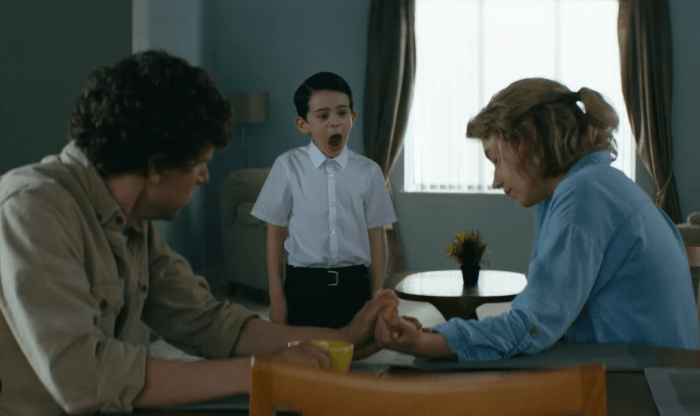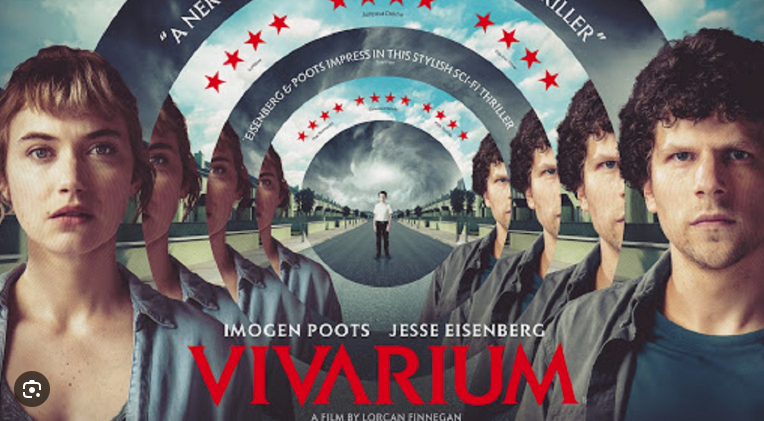VIVARIUM (2019)
Vivarium (2019) is a surreal science-fiction thriller that explores the suffocating monotony of suburban life through a disturbing and enigmatic lens. Directed by Lorcan Finnegan, the film blends existential dread with eerie visual precision, delivering a nightmarish allegory about the traps we build around ourselves—and the ones we can’t escape.
Plot Overview
Tom (Jesse Eisenberg) and Gemma (Imogen Poots) are a young couple looking to buy their first home together. In search of the perfect place to settle down, they visit a strange real estate office and meet an unsettling agent named Martin, who introduces them to a new housing development called “Yonder.”
When they follow Martin to view house number 9, a pristine and identical unit in a seemingly endless suburb, the agent vanishes. Attempting to leave, Tom and Gemma soon realize they are trapped. No matter how far they drive or walk, they always end up back at house 9.
Things worsen when a mysterious cardboard box arrives, containing a baby and a note: “Raise the child and be released.” Thus begins their nightmarish existence—trapped in an artificial neighborhood, forced to care for a rapidly growing, inhuman child who mimics speech and behavior with unsettling precision.
As the days blend into each other, Tom and Gemma’s relationship begins to fray under the strain of isolation, hopelessness, and the surreal horror of their new reality.
Themes and Emotional Depth
Vivarium is a stark and metaphorical examination of modern life, particularly the suffocating expectations of suburban domesticity, parenthood, and conformity. The film plays like a fever dream version of settling down—house, child, daily routine—but twisted into something deeply sinister.
One of the central themes is entrapment. Whether it’s the literal maze of Yonder or the societal expectation to raise a family and “settle down,” the film suggests that these prescribed paths can feel like prisons. Gemma and Tom are stripped of agency, reduced to caretakers of something alien in a world designed to strip away identity.

The child, too, serves as a symbol: he’s not just unsettling because he’s different, but because he forces Tom and Gemma to conform to parental roles they didn’t choose. His presence emphasizes the loss of individuality and the psychological cost of forced obligation.
Ultimately, Vivarium is less about what’s happening and more about what it represents—how life, when reduced to repetition and obligation, can become a form of psychological horror.
Character Development and Performance
Imogen Poots as Gemma: Poots delivers a nuanced and heartbreaking performance as Gemma, who gradually becomes the emotional center of the story. Her transformation from hopeful homebuyer to desperate survivor is deeply affecting. As she struggles to maintain her humanity, Poots balances maternal instinct with mounting dread and defiance, making her the film’s most emotionally resonant character.

Jesse Eisenberg as Tom: Eisenberg plays Tom with a quiet frustration that builds toward hopeless obsession. His increasing detachment and fixation on escaping—most notably through digging a hole in the artificial yard—serves as a bleak metaphor for futile rebellion. Eisenberg brings a subtle intensity to a character who gradually loses his grip on reality.
Senan Jennings and Eanna Hardwicke as The Boy: Playing the child at different stages of growth, both actors portray the character with a disturbingly robotic cadence and alien mimicry. The boy’s shrill voice and unnatural behavior are central to the film’s unsettling atmosphere. He is less a character than a symbol of forced roles and inescapable cycles—and the actors play him accordingly, to terrifying effect.
Cinematography and Direction
Lorcan Finnegan’s direction is coldly precise, enhancing the unnatural setting of Yonder with sterile colors and geometric repetition. Every house is the same, every sky is perpetually overcast, and every blade of grass seems placed with robotic symmetry. The set design emphasizes artificiality, making the characters feel like test subjects in a sterile experiment.

The cinematography leans heavily on symmetry and wide shots, reinforcing the feeling of entrapment and helplessness. Interior scenes feel claustrophobic, while exterior shots highlight the endless, uncanny sprawl of the neighborhood. There is no escape—visually or emotionally.
The score is minimal, eerie, and effective, often relying on ambient drones and sudden distortions that mirror the characters’ descent into despair. The sound design adds to the surreal atmosphere, with the boy’s voice and peculiar vocal mimicry acting as a kind of sonic assault.
Final Verdict
Vivarium (2019) is a haunting, thought-provoking sci-fi horror that uses surrealism and allegory to critique modern domestic life. With strong performances, particularly from Imogen Poots, and chilling world-building, it offers a slow-burn exploration of existential dread. It doesn’t provide easy answers—in fact, it thrives on ambiguity—but it leaves a lasting impression on anyone willing to confront the darker metaphors it presents.

It’s a film that demands interpretation, discomfort, and reflection. While not for everyone due to its repetitive structure and opaque narrative, Vivarium is a rare kind of horror—one that crawls under your skin not with screams, but with silence and structure.
Rating: 8/10
Vivarium is a claustrophobic and cerebral horror film that turns suburban dreams into an existential trap. Perfect for fans of symbolic cinema, eerie minimalism, and psychological torment.
